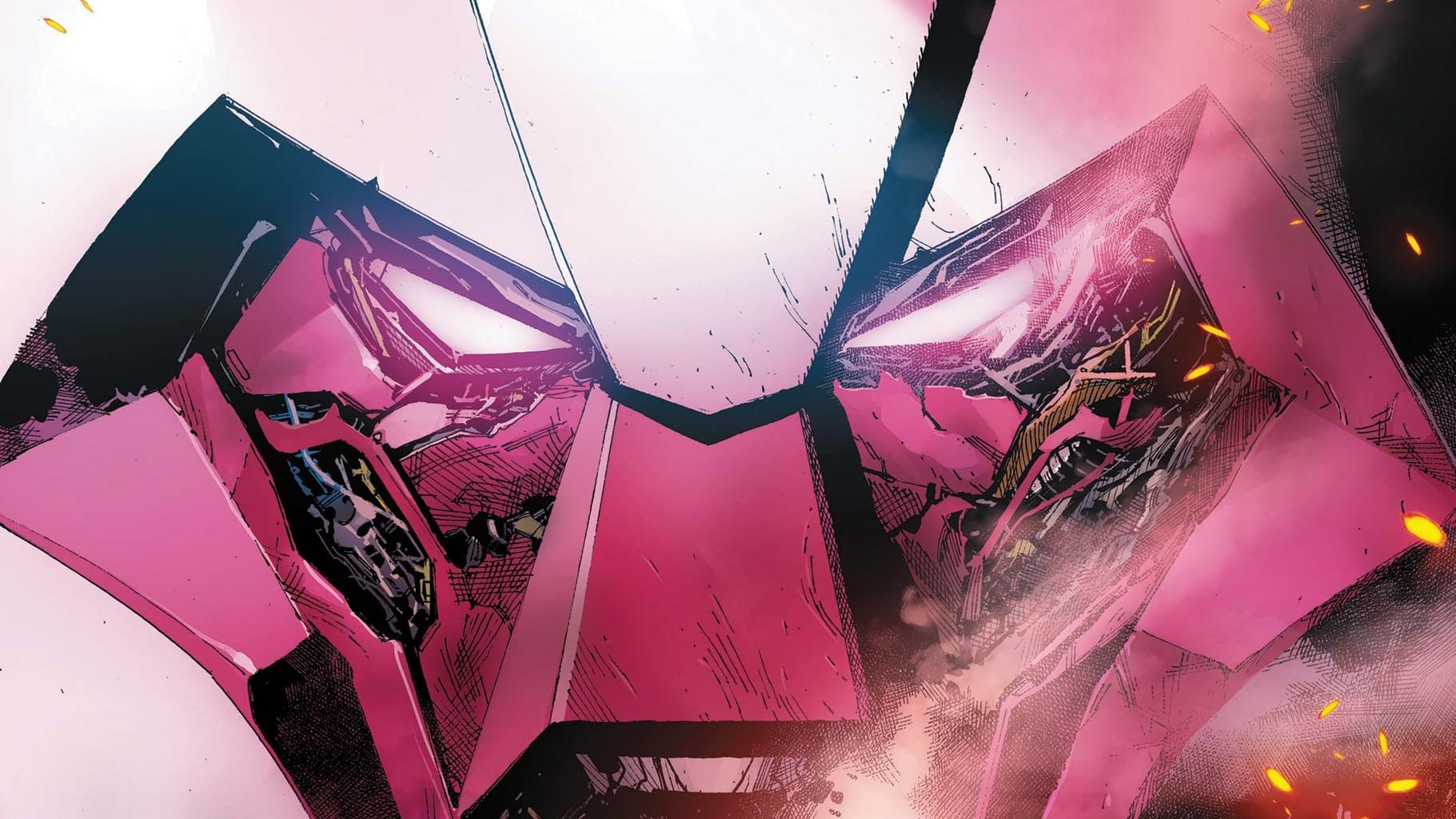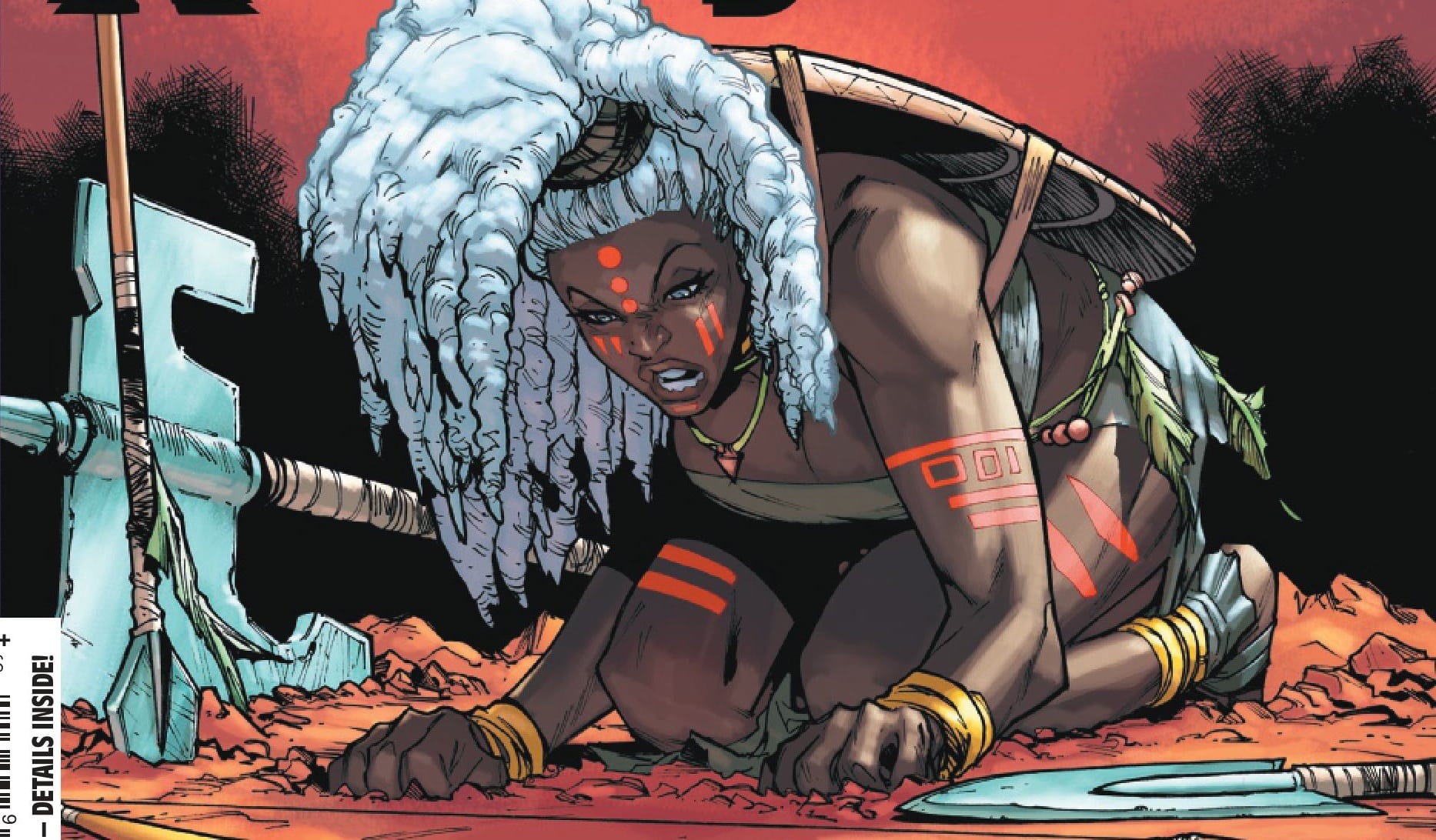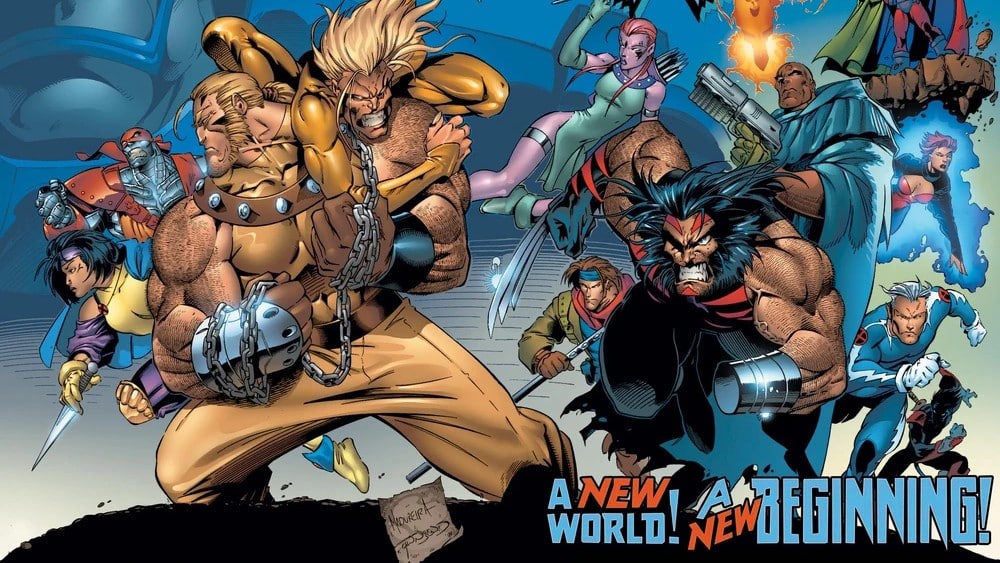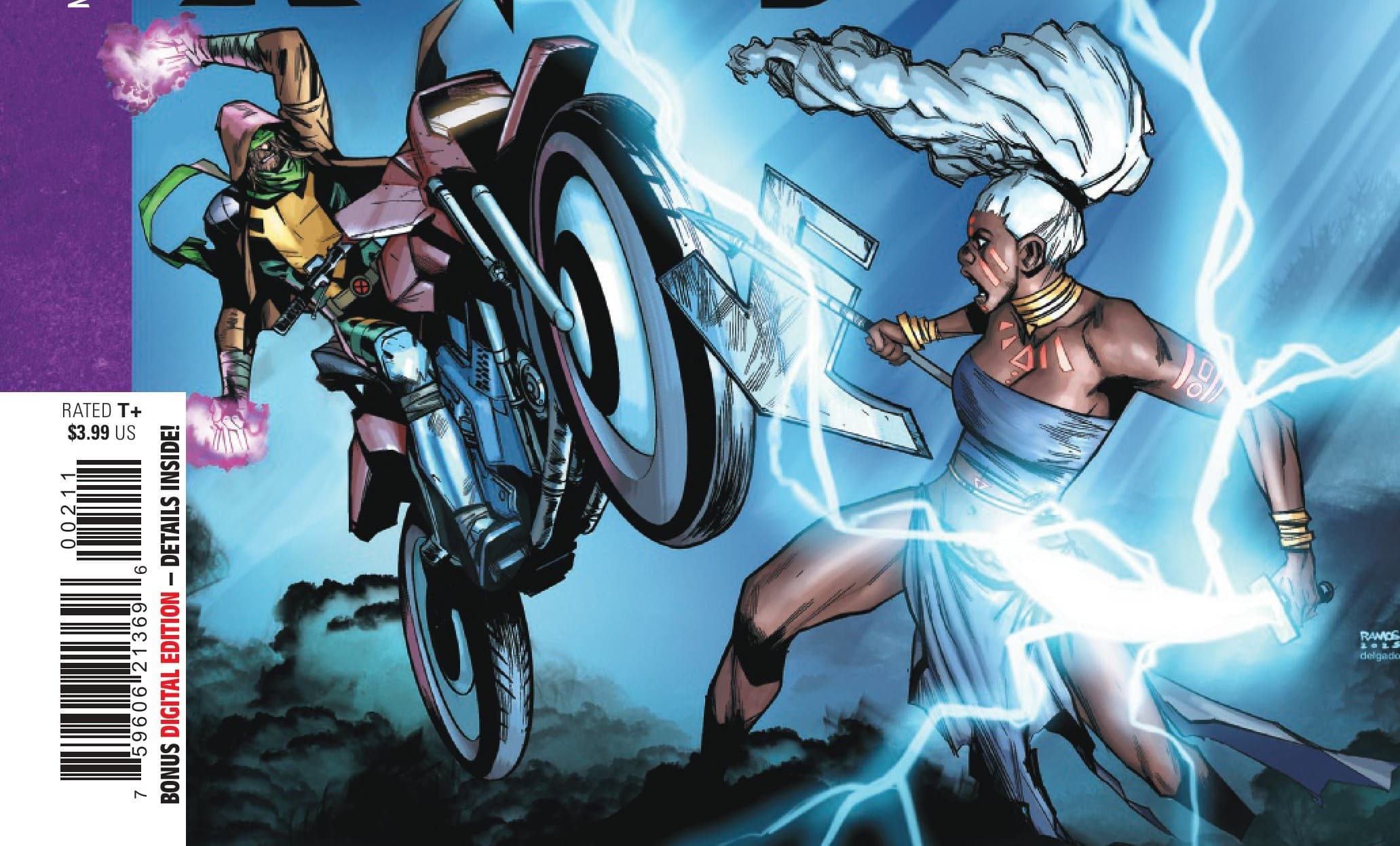Just as birds chirp, bees buzz, and mutants never die, so too is the inevitability of Nimrod. Witness his return in X-Men #20 written by Jonathan Hickman, art by Francesco Mobili, colors by Sunny Gho, and letters by Clayton Cowles.
Chris Eddleman: It’s been an entire month, and a part of me relished a little bit of a break, but another part of me is hungry Rob. And while you were hungry for something more aquatic, I’m hungry for the return of a certain pink and white pal. You know him, you love him, he’s Very Very Sorry, and he’s sitting pretty on the front of this comic—it’s Nimrod of course! In our penultimate issue, we dig into the return of this classic X-Men villain turned modern classic X-Men villain in Powers of X. I’m ready to dive in.
Robert Secundus: One last stop before the Gala! I’m ready for that party, but for now:
Too Much Annihilation on Their Minds

CE: We begin our issue in the Oracle, where the mask of Destiny stands vigil, as Mystique is still being strung along after 14 additional issues. We move into Forge’s waterfall lab (all the coolest hangouts are behind waterfalls to be honest) and Mystique requests an incredibly powerful weapon. Why? The eternal reason these days. Humans are afoot, specifically Orchis aboard their sunbathed forge in inner space. But those facts, while interesting, aren’t quite as interesting to me as Forge and Mystique’s conversation. They bring up a fairly familiar line that we’ve all heard, especially those of us from states packed with gun-toters—it’s not about the tool that you use, but merely how you use it.
Forge mentions that while he’s made gobs and gobs of weapons across the years, knowing that he’s made tools of a singular purpose helps him sleep at night, especially given one fact. It’s not about the tool, it’s about who wields it. I’ve always found this argument a little tired, because while it’s of course true, it’s always so reductive in real life. Obviously guns don’t just wake up by themselves and kill people, but they sure are of a singular purpose. Harm. How did you find this discussion?
RS: I’m not entirely sure what it’s doing here; Forge accepts that he has a human notion of morality of weapons, but insists he’s more honest about his reasoning. He turns the discussion to question Mystique, to put into doubt her own morality. The conversation hinges around annihilation. It’s hinting at things, but I’m not sure what. Looking at the broader context, Forge is involved in X-Force, the most consistently clearly immoral (and clearly human, being modelled after the CIA) aspect of Krakoan society at the moment. Mystique is acting under Destiny’s advice to burn Krakoa to the ground if it does, in fact, refuse to act morally, if the society refuses to restore Mystique’s wife. She is perhaps the character in the run thus far most clearly positioned as a moral figure, a sharp inversion of the typical ambiguity in which we typically find her. And as a whole they’re both contrasted with Orchis in this issue, and their own creation of, essentially, another kind of gun. Did I find the discussion engaging? I did; I enjoy most of Hickman’s Characters Having Conversations Of Great Important dialogue. But do I know what to make of it? Not really.
CE: I think like most of them, they’re more kind of about the rhetoric than any actual conclusion therein. I think what I most got out of it was about Forge and Mystique, two people of previously dubious characters. Regardless of their actions, they have a clarity of purpose. They aren’t deluding themselves. They are making weapons, they are weapons, they are annihilating. Mystique didn’t beat around the bush about it. But of course, she is still self-serving if even for the good of a nation. But even in so, she is being denied something unfairly, to a point that even she doesn’t fully understand. She’s railing against unfairness, and is being drastic. That isn’t really new for her though, she’s regularly been a character of no restraint.
I did enjoy that Forge said his worst weapon he ever made was one that turned mutants into humans [Ed. note: That was all the way back in Uncanny X-Men #185, Storm lost her powers for a while]. I wonder if that’s meant to be metaphorical as well. Mutants in this era have a rule about not murdering humans—ah but of course that isn’t for acts of war right? Slipping into humanity bit by bit.
This conversation was rendered of course by Mobili and Gho, and while I’m still pretty onboard for Gho’s colors, I found the conversation pieces to not be fantastically paced, even if the myriad angles presented worked well to break things up and keep it interesting. I think Mobili’s best work in this issue was the triptych panels where Nimrod discovers Mystique. It worked well both as a comedy bit and a point on which to begin the dynamic action.
What is a Man? A Miserable Little Pile of Nimrods.

RS: Speaking of “slipping humanity,” we have, as mentioned in the opening, the first chronological appearance of Nimrod, the Sentinel who was briefly a Superhero, the machine that, at times, seems like a man. Chris, what did you think of Nimrod’s birth?
CE: So this was an interesting take on it. When last we saw this Orchis base (and it’s been a bit), this was kind of hinted at, a version of human resurrection. But of course, we’ve seen in this era that humanity doesn’t tend to improve themselves in natural seeming ways, they have to do things like shove their husband’s psyche into a self-replicating murder robot. This was pretty surprising, there wasn’t any indication that Orchis was ready for Nimrod times, but that’s kind the point of Nimrod in this run, he’s a singularity of human evil, inevitable and impossible to stop. He’s the tipping point from humans being on their back foot to seemingly being a real threat. But the fact that he’s given humanity in the form of Erasmus is pretty interesting, and gives us an intriguing story beat.
Dr. Gregor basically wanted her husband back, but a wrench is thrown into that plan via Mystique, who is attempting to blow up the station. Things start to go sideways pretty quickly, and ultimately Erasmus is again no more. I felt like the sacrifice of his humanity was a real motif here, what is more post human than literally giving up the human side of oneself.
RS: It is a compelling and complicated origin for the character. On the one hand, his “humanity” may have been sacrificed, as he no longer has the Erasmus personality— but the result is not a cold, inhuman thing. The first thing he does is apologize, and the second is, in a rage, proclaim: “When you return home, tell your masters that I was born into existence… and the first thing I experienced beyond the love of my creator was pain and loss at your hands. I am Nimrod the Hunter. You were here at my beginning. I swear… I will see to your end.” The anger, rage, and vengeance is all, unfortunately, deeply human. Nimrod appears to be human, or at least, appears to be a person— but he’s a person shaped by the loss of personality. His persona is an absence of a persona. I favor the old medieval sense of “evil” as an absence of a good— and in that sense, he is a person defined by evil, defined by absence. That’s horrifying.
CE: Him apologizing was a bit from Powers of X as well. He gave a deep “sincere” apology to Cylobel before dunking her in the femtofluid. So forgive me if I find it a little more pretending to be human than actually being human. But I find the conceit of the story to be interesting.
Nimrod can duplicate himself but at least for some time, every duplicate of himself is the whole of himself. Said simply, any body destroyed is every body destroyed for the sake of Erasmus’s humanity. It kind of feels Ship of Theseus adjacent but with a really clear solution. In each additional part of Nimrod a Nimrod, yes, but the Erasmus portion has not pervaded the whole of Nimrod yet, which means him splitting into several pieces opens him up for destruction, as the new Nimrod may contain the whole of Erasmus. I know that it was simply for story convenience, but it felt kind of clever by design. I kind of had to sit with it for a while, which for me indicates an intriguing concept.
An Issue of Scaffolding

RS: The final issue of the series is going to be part of a crossover; this is the final standalone issue of the run, so I think it’s appropriate to look back at the run as a whole, to look at how this fits in with this 21ish part story. I think if we look to the previous two issues as well as this one, we’ll see how Hickman is choosing to structure this story: a dozen plotlines have been seeded, and so any issue at any moment can return to them, advance them, or conclude them. This is a nicely flexible structure that I think has worked to the series’ success.
A lot of the books have suffered after X of Swords, because it looks like they just weren’t prepared to deal with the COVID-restructuring and the increased gap between that event and The Hellfire Gala. There’s been a lot of meandering. But with X-Men, we got a huge payoff to the Children of the Vault Storyline, and then we got this issue, which returned to the primary antagonists of the run, the events of House of X, and the dangers of Powers of X, finally bringing into being one of the most powerful and, at times, horrifying villains in X-Men history. I don’t know if these were originally planned here, but it feels like at any moment, in any issue, if things have gotten boring, or if there is new space, X-Men has been ready to drop some major bombs. Still, and again, especially in contrast to the previous two issues, this issue felt a bit wanting to me.
CE: It was a mirror to X-Men #6, but that issue was also pretty light, and a tiny bit decompressed like this one. You can tell that to some extent, Hickman was given kind of carte blanche to tell a lengthy story. But in some ways, it’s still points on a line rather than music, seeds in the ground instead of a beautiful flower. It still feels like in some ways this story has barely begun, even as the Vault has gotten these massive pay-offs. It’s incredibly long term as new comics go, but that does lead to some likely unintended but still prevalent issues.
Mystique is one of the only queer women in X-Men comics, a number that is currently in low single digits. This was confirmed at the beginning of this era in History of the Marvel Universe but then extra extra confirmed in X-Men #6. Literally said she had a wife. There’s no way out of this one. But regardless, there are not really any lesbian or simply wlw couples in X-Men comics right now. There’s some in the background but, Mystique’s story is really probably the most forward facing queer story in X-Men right now, which is a conscious decision by the folks working on these books.
And it’s a tragic story. She is not only not able to reunite with her long-dead long, but she is being cruelly kept from her through lies by Charles and Erik for the sake of Moira. And it’s being incredibly stretched out. So through this structure, this long term writing, we have an extra prolonged bit of queer misery. In a vacuum, it’s a story. In the context of a line of comics that is known to appeal to queer readers, in a company that seems to be cautious, if not outwardly silent, about confirming any sort of queer characters, especially popular ones. This is incredibly frustrating, and it’s really just adding insult to injury, whether intended or not. This type of storytelling has great potential, especially in modern “read for the trade” comics, but this structure along with this subject matter is heaping on misery when it already feels raw.
RS: It is also a problem especially heightened by the extremely specific gap of wlw representation in this line; Kate Pryde’s kiss and Magik’s space-flirtation, which we assumed finally made canon these consistently subtextually wlw characters, have not received any followup. Runaways’ recent encounter with Krakoa teased a queer Pixie, but then failed to deliver. Right now, Marvel’s most prominent lesbian character, Karma, still has never had an on page girlfriend, and the narrative seems to continuously tease a romance with Mirage that it has thus far not delivered. Minor characters have been allowed to begin romances in the background— see X-Factor and Way of X— but major characters in this specific area of representation remain overlooked.
And then, on top of all that, this is a problem structurally with the series. As I said earlier, Mystique has been positioned as our moral compass. Krakoa has many, many ethically positive aspects, but it also features deep moral flaws; it’s not a utopia, but a society being built by flawed people. When we get into discussions of the nature of this society, things get very complex and very abstract— but in the narrative things are neither complex nor abstract for Mystique. She hones all these complications into a sharp question: will they treat one person equitably? Will they give her her wife back?
So many plot threads loom over the series— Arrako, Doom, Nimrod, Killian Devo and his whole mysterious deal, Orchis, the plant grandmas, tensions between the rulers of this society and its people, tensions which are about to result in a new team of X-Men, the Scarlet Witch, the Children of the Vault, the Brood, Moira herself, and hell, wherever all those Powers of X characters went when they went through that black hole, because you just know they’re still out there—
There are so many plot threads, but the one that feels like it has the most weight is Mystique’s. The threat that she will literally burn Krakoa to the ground may, from a pure Power Levels perspective or whatever, seem less dangerous than the threat of a Nimrod, but it has been positioned as the most central thread of the series. It began in one of the most memorable scenes in a series packed with them; it began in HoXPoX with an infernal blaze, with Moira’s fiery death. It continued in one of the most striking issues of the run. It recurs here in the final issue before the game-changing Gala. It is positioned as vital to the ongoing story. And thematically it gets at a central question few of the other ongoing plots do: can a society, no matter how morally constructed, no matter how just its existence, do good if it is lead and shaped by a man as flawed as Charles Xavier?
So when we return to it and, well, when nothing moves forward, it feels immensely frustrating. And it’s even more frustrating given the contexts we’ve mentioned. Of all the plotlines, it feels like this one needs to be advanced soon, and that advancement needs to happen in a big way.
X-Traneous Thoughts

- Krakoan Reads: To The Stars
- Killian Devo’s weird sunglasses are just eternally odd to me.
- Moira! Moira! Moira!
- Also Moira is reading Destiny’s Books, originally predictions of the future from X-Treme X-Men.
- Odd that Forge’s most powerful weapon doesn’t do nearly the damage it was supposed to? Did it fail? Was it sabotaged? Or did he lie about its design?
- The review copy that was provided to us didn’t include the ad for “Inferno”, so we are just as surprised as you







